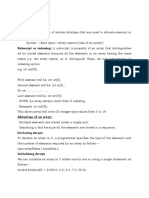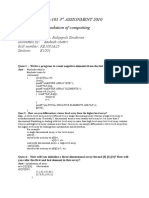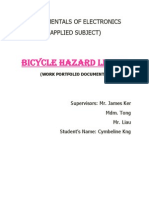C-Notes Module 4
Uploaded by
jagatamil2016C-Notes Module 4
Uploaded by
jagatamil2016MODULE – IV
Arrays: Declaration and Initialization of one and two dimensional arrays –
Multidimensional array – dynamic arrays - Character arrays and strings.
Structure: Defining and processing. Structure initialization Operations on
individual members Arrays of structure, Arrays within Structure, Structure and
Functions- Passing to a function.
Array
Array is the group of identical elements organized in a single variable. An array is a
collection of data that holds fixed number of values of same type. For example: if you want
to store marks of 100 students, you can create an array for it.
int mark[100];
Arrays are of three types:
i. One-dimensional arrays
int mark[5] = {19, 10, 8, 17, 9};
Arrays have 0 as the first index not 1. In this example, mark[0]
If the size of an array is n, to access the last element, (n-1) index is used. In this example,
mark[4]
ii. Two dimensional array
The 2D array is organized as matrices which can be represented as the collection of rows and
columns.
The syntax to declare the 2D array is given below.
data_type array_name[rows][columns];
example
int rain[4][3];
the above example will create 4rows and 3 columns at main memory. So we can store up to
12 integers.
Row\Column 1 2 3
1
2
3
4
J. JAGADEESAN, ASST. PROFESSOR OF COMPUTER SCIENCE, AAGASC, Karaikal-609605
iii. Multidimensional arrays
In C programming, you can create an array of
arrays known as multidimensional array. For
example,
float x[3][4];
Here, x is a two-dimensional (2d) array. The
array can hold 12 elements. You can think the array
as table with 3 row and each row has 4 column.
Similarly, you can declare a three-dimensional (3d) array. For example,
float y[2][4][3];
Here, The array y can hold 24 elements.
Example : Each 2 elements have 4 elements, which makes 8 elements and each 8 elements
can have 3 elements. Hence, the total number of elements is 24.
/* ................... Largest Number among N numbers ......... */
#include<stdio.h>
#include<conio.h>
void main()
{
int a[100],i,l,n;
clrscr();
printf("Enter N value ");
scanf("%d",&n);
for(i=1;i<=n;i++)
{
scanf("%d",&a[i]);
}
l=a[1];
for(i=2;i<=n;i++)
{
if(a[i]>l)
l=a[i];
}
printf("Large = %d",l);
getch();
}
/* Output */
Enter Number of numbers 7
45 67 78 136 12 34 67
Large = 136
J. JAGADEESAN, ASST. PROFESSOR OF COMPUTER SCIENCE, AAGASC, Karaikal-609605
Character Array or C Strings
The string can be defined as the one-dimensional array of characters terminated by a null ('\0').
The character array or the string is used to manipulate text such as word or sentences. Each character in
the array occupies one byte of memory, and the last character must always be 0. The termination
character ('\0') is important in a string since it is the only way to identify where the string ends. When
we define a string as char s[10], the character s[10] is implicitly initialized with the null in the memory.
There are two ways to declare a string in c language.
By char array
By string literal
Let's see the example of declaring string by char array in C language.
char ch[10]={'c', 'o', 'm', 'p', 'u', 't', 'e', 'r', ''\0'};
or
char ch[10]="computer”
As we know, array index starts from 0, so it will be represented as in the figure given below.
ch
Index 0 1 2 3 4 5 6 7 8
Value c o m p u t e r \0
Example
Let's see an example of counting the number of vowels in a string.
#include<stdio.h>
void main ()
{
char s[11] = "computer";
int i = 0;
int count = 0;
while(i<11)
{
if(s[i]=='a' || s[i] == 'e' || s[i] == 'i' || s[i] == 'u' || s[i] == 'o')
{
count ++;
}
i++;
}
printf("The number of vowels %d",count);
}
Output
The number of vowels 3
J. JAGADEESAN, ASST. PROFESSOR OF COMPUTER SCIENCE, AAGASC, Karaikal-609605
Structures
A structure is a user defined data type in C. A structure creates a data type that can be used to group
items of possibly different types into a single type.
Defining a Structure
To define a structure, you must use the struct statement. The struct statement defines a new data
type, with more than one member. The format of the struct statement is as follows −
struct [structure tag] {
member definition;
member definition;
...
member definition;
} [one or more structure variables];
The structure tag is optional and each member definition is a normal variable definition, such as int
i; or float f; or any other valid variable definition. At the end of the structure's definition, before the
final semicolon, you can specify one or more structure variables but it is optional. Here is the way we
would declare the Book structure −
struct Books {
char title[50];
char author[50];
char subject[100];
int book_id;
} book;
How to access structure elements?
Structure members are accessed using dot (.) operator.
#include<stdio.h>
struct Point
{
int x, y;
};
void main()
{
struct Point p1 = {0, 1};
/* Accessing members of point p1 */
p1.x = 20;
printf ("x = %d, y = %d", p1.x, p1.y);
}
Output:
x = 20, y = 1
J. JAGADEESAN, ASST. PROFESSOR OF COMPUTER SCIENCE, AAGASC, Karaikal-609605
Array of structures
Like other primitive data types, we can create an array of structures.
Example
struct Point
{
int x, y;
};
void main()
{
// Create an array of structures
struct Point p[10];
// Access array members
p[0].x = 10;
p[0].y = 20;
p[1].x = 12;
p[1].y = 25;
printf("%d %d", p[0].x, p[0].y);
printf("%d %d", p[1].x, p[1].y);
}
Structure and Function
A structure can be passed to any function from main function or from any sub function
PASSING STRUCTURE TO FUNCTION IN C:
It can be done in below 3 ways.
1. Passing structure to a function by value
2. Passing structure to a function by address(reference)
3. No need to pass a structure – Declare structure variable as global
In the below example student structure having id, name and percentage attributes. record
is the variable to control entire structure.
Example:
#include <stdio.h>
#include <string.h>
struct student
{
int id;
char name[20];
float percentage;
};
J. JAGADEESAN, ASST. PROFESSOR OF COMPUTER SCIENCE, AAGASC, Karaikal-609605
void func(struct student record)
{
printf(" Id is: %d \n", record.id);
printf(" Name is: %s \n", record.name);
printf(" Percentage is: %f \n", record.percentage);
}
int main()
{
struct student record;
record.id=1;
strcpy(record.name, "Raju");
record.percentage = 86.5;
func(record);
return 0;
}
OUTPUT:
Id is: 1
Name is: Raju
Percentage is: 86.5
J. JAGADEESAN, ASST. PROFESSOR OF COMPUTER SCIENCE, AAGASC, Karaikal-609605
You might also like
- Without This Message by Purchasing Novapdf : Print To PDFNo ratings yetWithout This Message by Purchasing Novapdf : Print To PDF11 pages
- Pointers (Part 2), Structures (Part 2), UnionsNo ratings yetPointers (Part 2), Structures (Part 2), Unions37 pages
- C Programming Tutorial - Part I: CS 537 - Introduction To Operating SystemsNo ratings yetC Programming Tutorial - Part I: CS 537 - Introduction To Operating Systems28 pages
- Lecture 7 - Introduction To Data StructuresNo ratings yetLecture 7 - Introduction To Data Structures60 pages
- CSE-101 3 Assignment 2010 Foundation of Computting Submitted ToNo ratings yetCSE-101 3 Assignment 2010 Foundation of Computting Submitted To3 pages
- Defining A Structure: Title Author Subject Book IDNo ratings yetDefining A Structure: Title Author Subject Book ID8 pages
- Differentiate Between Data Type and Data StructuresNo ratings yetDifferentiate Between Data Type and Data Structures11 pages
- Apache CloudStack 4.0.0 Incubating API Developers Guide en USNo ratings yetApache CloudStack 4.0.0 Incubating API Developers Guide en US44 pages
- Bicycle Hazard Lights: Fundamentals of Electronics (Applied Subject)No ratings yetBicycle Hazard Lights: Fundamentals of Electronics (Applied Subject)33 pages
- Dynamic Memory Allocation in C Using MallocNo ratings yetDynamic Memory Allocation in C Using Malloc3 pages
- [FREE PDF sample] CURRENT Diagnosis Treatment Gastroenterology Hepatology Endoscopy 1st Edition Norton Greenberger ebooksNo ratings yet[FREE PDF sample] CURRENT Diagnosis Treatment Gastroenterology Hepatology Endoscopy 1st Edition Norton Greenberger ebooks67 pages
- SSGC Test MCQS For Electrical and Electronics100% (1)SSGC Test MCQS For Electrical and Electronics5 pages
- 8.05 Quadrilaterals Built From Triangles - WorksheetNo ratings yet8.05 Quadrilaterals Built From Triangles - Worksheet7 pages
- Indore Branch of Circ of Icai: Mr. Saurabh ParikhNo ratings yetIndore Branch of Circ of Icai: Mr. Saurabh Parikh32 pages
- DuctWatch IR Gas Detector Instruction ManualNo ratings yetDuctWatch IR Gas Detector Instruction Manual32 pages
- Cosine Rule (Law of Cosines) - Brilliant Math & Science WikiNo ratings yetCosine Rule (Law of Cosines) - Brilliant Math & Science Wiki7 pages
- CHE 324 (Dr. Garba's Part) Chemical Engineering Thermodynamics II (2 Credits)No ratings yetCHE 324 (Dr. Garba's Part) Chemical Engineering Thermodynamics II (2 Credits)10 pages
- B. Exegetical Bible Study Methods F. Schaeffer100% (2)B. Exegetical Bible Study Methods F. Schaeffer26 pages
- Transformers, How Do They Work?: Generative AI To Create ContentNo ratings yetTransformers, How Do They Work?: Generative AI To Create Content14 pages
- S9Fe-Lve-42: Grade Level 9 Quarter / Domain Week No. LC CodeNo ratings yetS9Fe-Lve-42: Grade Level 9 Quarter / Domain Week No. LC Code6 pages
- Performance Enhancement of Low Pressure Turbine Cascade by Introducing Tubercles100% (1)Performance Enhancement of Low Pressure Turbine Cascade by Introducing Tubercles7 pages
- Without This Message by Purchasing Novapdf : Print To PDFWithout This Message by Purchasing Novapdf : Print To PDF
- C Programming Tutorial - Part I: CS 537 - Introduction To Operating SystemsC Programming Tutorial - Part I: CS 537 - Introduction To Operating Systems
- CSE-101 3 Assignment 2010 Foundation of Computting Submitted ToCSE-101 3 Assignment 2010 Foundation of Computting Submitted To
- Defining A Structure: Title Author Subject Book IDDefining A Structure: Title Author Subject Book ID
- Differentiate Between Data Type and Data StructuresDifferentiate Between Data Type and Data Structures
- Advanced C Concepts and Programming: First EditionFrom EverandAdvanced C Concepts and Programming: First Edition
- Apache CloudStack 4.0.0 Incubating API Developers Guide en USApache CloudStack 4.0.0 Incubating API Developers Guide en US
- Bicycle Hazard Lights: Fundamentals of Electronics (Applied Subject)Bicycle Hazard Lights: Fundamentals of Electronics (Applied Subject)
- [FREE PDF sample] CURRENT Diagnosis Treatment Gastroenterology Hepatology Endoscopy 1st Edition Norton Greenberger ebooks[FREE PDF sample] CURRENT Diagnosis Treatment Gastroenterology Hepatology Endoscopy 1st Edition Norton Greenberger ebooks
- 8.05 Quadrilaterals Built From Triangles - Worksheet8.05 Quadrilaterals Built From Triangles - Worksheet
- Cosine Rule (Law of Cosines) - Brilliant Math & Science WikiCosine Rule (Law of Cosines) - Brilliant Math & Science Wiki
- CHE 324 (Dr. Garba's Part) Chemical Engineering Thermodynamics II (2 Credits)CHE 324 (Dr. Garba's Part) Chemical Engineering Thermodynamics II (2 Credits)
- Transformers, How Do They Work?: Generative AI To Create ContentTransformers, How Do They Work?: Generative AI To Create Content
- S9Fe-Lve-42: Grade Level 9 Quarter / Domain Week No. LC CodeS9Fe-Lve-42: Grade Level 9 Quarter / Domain Week No. LC Code
- Performance Enhancement of Low Pressure Turbine Cascade by Introducing TuberclesPerformance Enhancement of Low Pressure Turbine Cascade by Introducing Tubercles
























































































